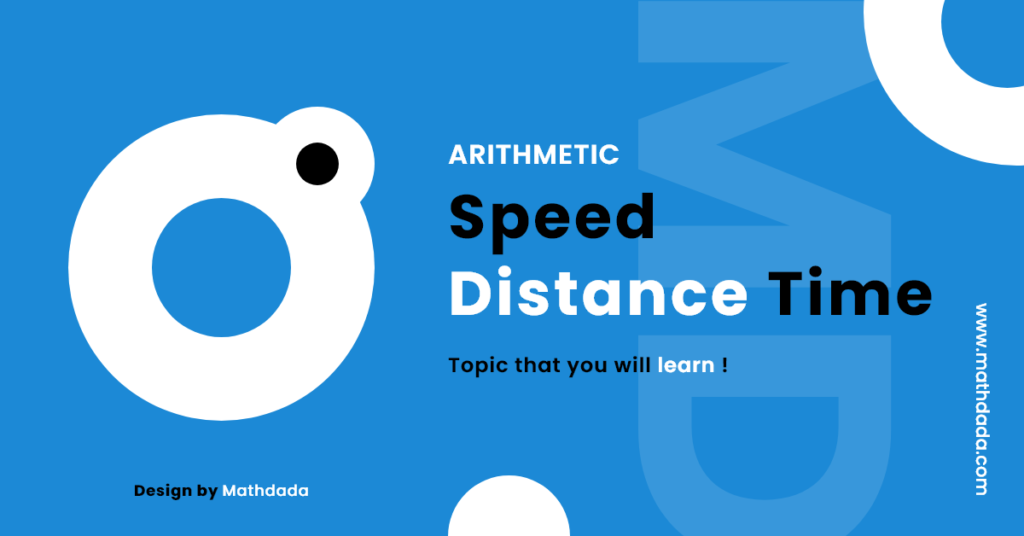Table of Contents
Relationship between speed distance and time is expressed by
\[Speed=\frac{\text{Distance}}{Time}\]
\[\Rightarrow \text{Distance}=Speed\times Time\]
This expression shows that – Speed is directly proportional to distance. If the speed is doubled, then distance traveled in the same time, will also be doubled. Distance and time are directly proportional. If distance to be traveled is doubled, then the time taken would also be doubled at the same speed. Time is inversely proportional to speed. If the distance remains the same and speed is doubled, then time taken to travel the same distance becomes half of the original time taken at the original speed.
Average Speed – Speed Distance and Time
The average speed for equal distance is given by
\[\text{Average Speed}=\frac{\text{Total distance}}{\text{Total time}}\]
Now, let the speed of a person in travelling a distance D km to and from is x km/h and y km/y, respectively.
\[\therefore \text{Average Speed}=\frac{\text{Total distance}}{\text{Total time}}\]
\[=\frac{2D}{\frac{D}{x}+\frac{D}{y}}=\frac{2xy}{x+y}km/h.\]
In travelling equal distance with speed x and y, the average speed is expressed as \left( \frac{2xy}{x+y} \right)
Relative Speed
Relative speed is the speed of a moving object in relation to other moving object. It is often seen, while sitting in a moving train, speed of the train increases when another train moving in the opposite direction crosses it. The speed appears decreasing when another train moving in the parallel track in the same direction passes it. Hence, this feeling of change in speed of train is nothing but its relative speed in relation to another moving train.
Therefore, the relative speed of a moving body with speed x km/h in relation to the other moving body with speed y km/h.
(a) in same direction is difference of their speed i.e., \left( x-y \right)km/h.
(b) in opposite direction is the sum of their speeds i.e., \left( x+y \right)km/h.
Concept of Relative Speed in Motion of Trains
Application of relative speed in solving questions of trains is same as used in the previous examples. Here are given some important points in problems on trains.

If two trains with speed u km/h and v km/h move in the same directions, then their relative speed \left( u-v \right)km/h,where~~u>v.
If two trains with speed u km/h and v km/h move in the opposite directions, then their relative speed \left( u+v \right)km/h.
If two of length x km and y km are moving in the opposite direction at u km/h and v km/m, then the time taken by the trains to cross each other \left( \frac{x+y}{u+v} \right)h.
Time taken by a train x meters long in passing a stationary object of y meters = Time is taken by the train to cover (x + y) meters. If two trains start at the same time from two points A and B towards each other and after crossing they take a and b hours in reaching B and A respectively. Then A~speed:~B~speed=\sqrt{b}:\sqrt{a}
Boats and Stream
The problems of boats and stream are also based on the basic relation of speed, distance and time

\[Speed=\frac{\text{Distance}}{Time}\]
In these questions, the direction along the stream (water) is called downstream and, the direction against the stream is called upstream.
If the speed of a boat in still water is x km/h and the speed of the stream is y km/h, then
Downstream speed=\left( x+y \right)km/h……..(I)
Upstream speed=\left( x-y \right)km/h……..(ii)
Adding equation (i) and (ii) we get
\[Downstream~~speed+Upstream~~speed=2x\]
\[\Rightarrow \left( Speed~~of~~the~~boat \right)~~x=\frac{Downstream~~speed+Upstream~~speed}{2}\]
Subtracting equation (i) and (ii) we get
\[Downstream~~speed-Upstream~~speed=2y\]
\[\Rightarrow \left( Speed~~of~~the~~stream \right)~~y=\frac{Downstream~~speed-Upstream~~speed}{2}\]
From the above relationship we conclude, if the downstream speed is u km/h and Upstream speed v km/h then
Speed of boat in still water=\left( \frac{u+v}{2} \right)km/h
Speed of stream=\left( \frac{u-v}{2} \right)km/h
Unitary Method |


